Spiders, those fascinating eight-legged creatures, have long captivated our imaginations with their intricate webs and stealthy hunting techniques. Found in almost every corner of the globe, these arachnids are known for their diverse species and remarkable adaptability.
As with any living organism, spiders have certain basic needs that must be met to ensure their survival and well-being. Among these needs is the question that often arises: which spider drinks water? Do all spiders drink or need water?
A Closer Look at Spiders’ Basic Needs
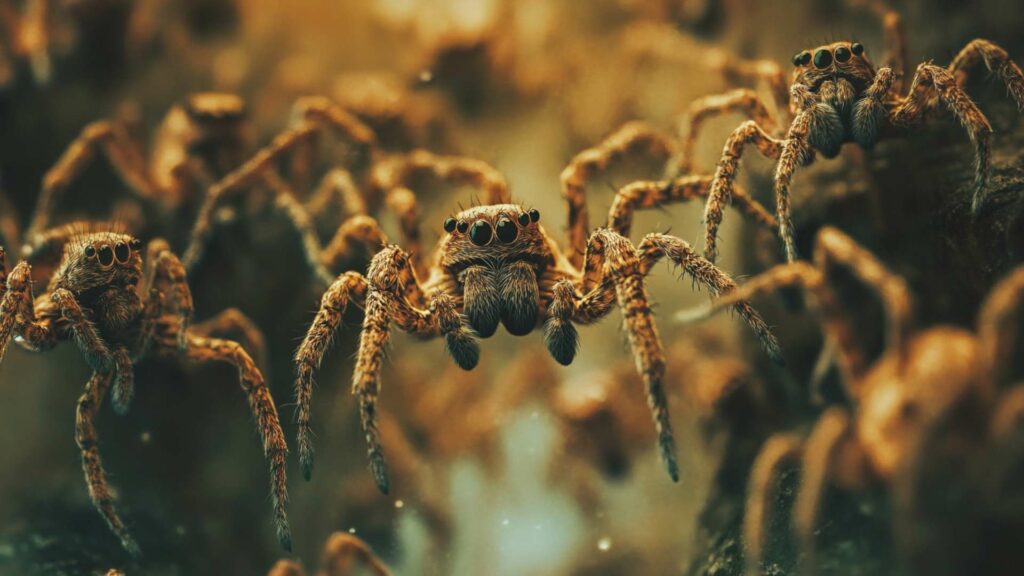
Before delving into the mysterious world of spiders’ hydration requirements, let’s take a moment to understand their overall needs. Like all living beings, spiders require sustenance to survive.
Their diet primarily consists of insects and other small creatures that happen to cross their paths. However, food alone does not guarantee a spider’s survival; access to water is equally crucial.
Do Spiders Need Water to Survive?
This simple yet profound question has intrigued both arachnologists and curious minds alike for years. While it might be tempting to assume that spiders can survive solely on prey moisture or utilize some secret method for acquiring water from other sources, the truth lies in understanding the unique physiology of these incredible creatures.
Water requirements of spiders
Spider physiology and water intake
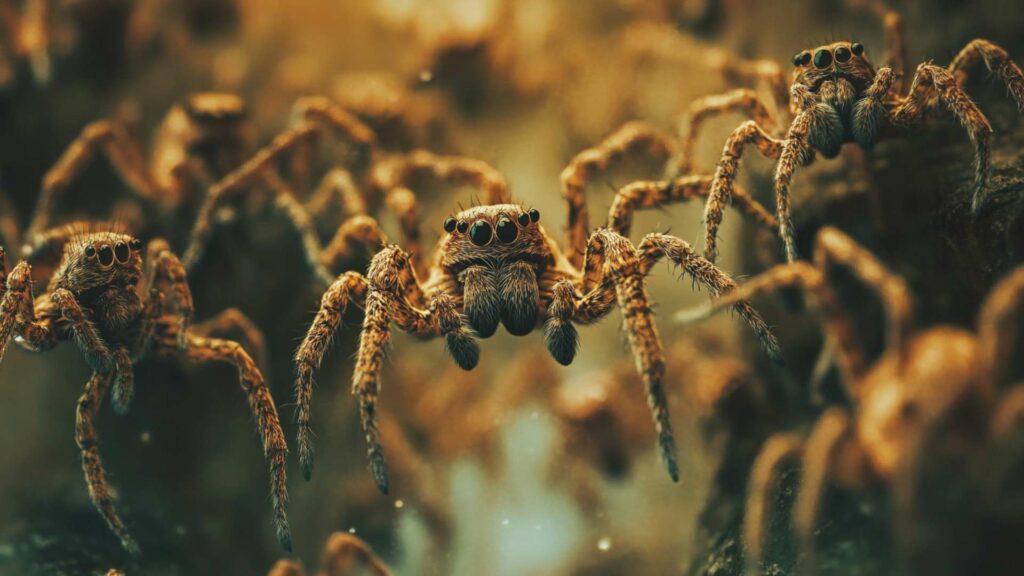
The Intricacies of a Spider’s Hydration, despite their seemingly alien-like appearance, share some commonalities with humans when it comes to drinking habits and the importance of water intake.
While spiders don’t have mouths like ours, they do possess specialized structures called spiracles located on their abdomen that allow them to breathe. These spiracles also play a crucial role in regulating water loss.
You see, spiders have an exoskeleton, a tough external covering that helps protect their delicate bodies from harm. However, this exoskeleton poses a challenge because spiders get it when it comes to retaining water.
To compensate for this, spiders have developed remarkable adaptations to prevent excessive water loss through their exoskeletons. Tiny hairs called setae cover the spider’s body and function as hydrophobic structures, repelling water away from the surface.
Additionally, some species possess an oily cuticle layer that further reduces moisture evaporation. These ingenious adaptations work together to minimize dehydration risks and enable spiders to thrive in diverse environments.
Spider exoskeleton and water loss prevention
The secret armor of wolf spider against dehydration The spider’s exoskeleton acts as both its armor and its Achilles’ heel concerning hydration.
While it provides protection against predators and external threats, it also creates challenges for maintaining adequate moisture levels within the spider’s body. Spiders can lose substantial amounts of water through their exoskeletons due to evaporation caused by ambient conditions such as heat or dryness.
To counteract this potential dehydration risk, spiders need to actively conserve water within their bodies by minimizing unnecessary losses. They achieve this through behavioral adaptations like staying hidden during hot periods or seeking out cooler microenvironments where moisture levels are higher.
Some species also exhibit behavioral changes during droughts by reducing activities such as building webs or remaining motionless for extended periods to conserve energy and moisture. Keeping hydrated is essential for spiders as water plays a vital role in various bodily functions.
Just like any living organism, spiders require proper hydration to ensure the optimal functioning of their internal systems. Water acts as a medium for vital metabolic reactions, facilitates nutrient absorption, and aids in waste elimination.
Without sufficient water intake, spiders would struggle to maintain their physiological balance and face potential health issues. Overall, spiders have evolved fascinating mechanisms to compensate for their unique exoskeletons’ challenges to drinking water and maintain adequate hydration levels.
In the wild, they rely on various sources such as rainwater or dew collection, consuming prey with higher moisture content, and adapting behaviorally during water scarcity periods. By understanding these intricate aspects of spider physiology and water intake, we can further appreciate these incredible creatures’ adaptability and survival skills.
Sources of water for spiders in the wild
Rainwater and dew collection by spiders
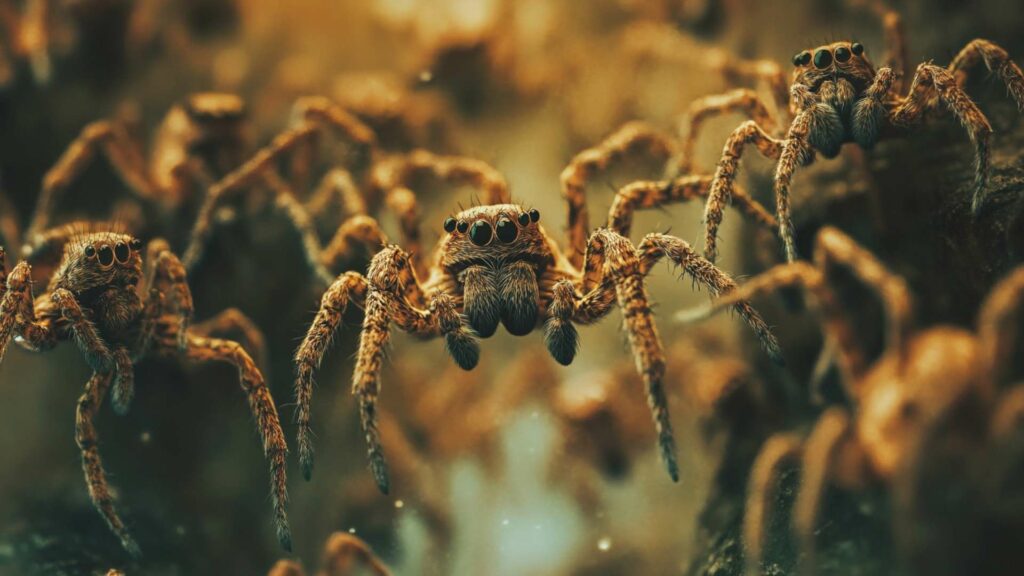
In the wild, where water sources may not always be readily available, spiders have evolved fascinating adaptations to ensure their hydration needs are met. One of their ingenious strategies involves collecting rainwater and dew.
When rain falls or dew forms on surfaces, spiders take advantage of these precious water droplets to quench their thirst. This ability to harness moisture from ambient conditions is particularly crucial for species like tarantulas and house spiders that reside in environments with limited access to standing water.
Spider adaptations for capturing raindrops and dew
Spiders possess remarkable adaptations that allow them to capture raindrops and dew effectively. Their exquisitely designed webs act as natural catchments for water collection. The intricate architecture of a spider’s web includes threads that are specifically engineered to attract and collect moisture.
These threads have a high surface area-to-volume ratio, enabling them to efficiently trap tiny droplets suspended in the air or on nearby surfaces. Moreover, some spiders possess specialized hairs or bristles on their bodies that aid in absorbing moisture from rain or dew directly.
These hydrophilic structures build webs that enable spiders to extract water droplets from even the briefest encounters with wet surfaces. The spiders drink ingenious combination of web design and physical adaptations allows them to obtain precious drops of water, ensuring they stay hydrated even during long periods without immediate access to conventional sources.
Once collected, the gathered water serves multiple purposes for spiders. It serves most spiders as a vital hydration source necessary for their bodily functions such as digestion and respiration.
Additionally, spiders utilize this collected liquid for maintaining the integrity of their webs, which serve as both shelter and traps for prey. By carefully managing this valuable resource through effective utilization, spiders demonstrate incredible adaptability in navigating diverse environments while ensuring they meet both their physiological needs and survival requirements.
Spiders possess remarkable capabilities to collect and utilize water from rain and dew in the wild. Through their intricate webs and physical adaptations, they have evolved to harvest and make use of even the smallest water droplets suspended in the air or accumulated on surfaces.
This ability not only ensures their hydration for survival but also plays a crucial role in maintaining their intricate webs, which are essential for catching prey. The resourcefulness displayed by these incredible arachnids further emphasizes the diversity of strategies employed by various species to thrive in challenging environmental conditions.
Water availability in spider habitats
The Thirsty Landscapes: Forests, Grasslands, Deserts, etc.
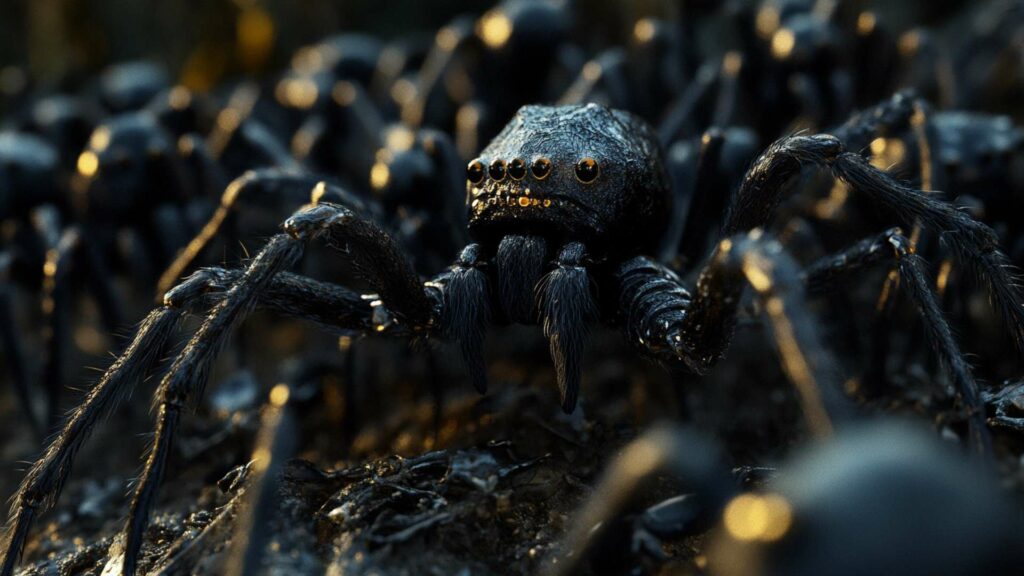
Spiders are highly adaptable creatures that can be found in a wide range of terrestrial habitats, including lush forests, sprawling grasslands, and even harsh deserts. However, the availability of water varies significantly among these ecosystems, posing unique challenges for our eight-legged friends. Factors such as precipitation patterns, humidity levels, and soil moisture play a crucial role in determining the accessibility of water sources for spiders.
In forested areas with ample rainfall, spiders have a relatively easier time finding a water source. The dense foliage traps moisture from rain and dewdrops on spider webs provide an additional hydration source.
Grasslands present a different scenario as they tend to experience erratic rainfall patterns. Spiders here primarily rely on collecting dew in the early morning or after rain showers to quench their thirst.
The real challenge arises in arid environments like deserts where water is scarce. In such punishing landscapes with limited access to liquid sustenance, spiders have evolved remarkable strategies to survive extended periods without food and stay hydrated.
Strategies of Water Seekers: How Spiders Find Water in Arid Environments
Adapting to their unforgiving surroundings, arachnids have developed ingenious ways to locate precious water sources within arid ecosystems. One notable strategy is employing their keen sense of touch through specialized leg hairs that can detect vibrations caused by nearby movements or irregularities on the ground’s surface.
Larger species like tarantulas are known to dig burrows deep into the earth where they can access underground reserves of moisture during dry spells. These resilient creatures also possess the ability to extract fluids from their prey’s bodies when it comes time for feeding – an efficient method for obtaining both sustenance and hydration simultaneously.
For those living above ground without food or access to water for long periods, spiders may resort to behaviors like going into torpor (a state of reduced metabolic activity) to conserve energy and minimize water loss. Some species of house spiders survive and even resort to cannibalism, consuming other spiders to acquire the moisture stored in their bodies.
Spiders have evolved various ingenious tactics to navigate diverse habitats and secure the water they need for survival. From capturing dewdrops on delicate webs in forests and grasslands to burrowing deep into the earth for underground reserves in deserts, these remarkable arachnids demonstrate an impressive ability to adapt and thrive even in the most challenging environments.
Water acquisition through prey consumption
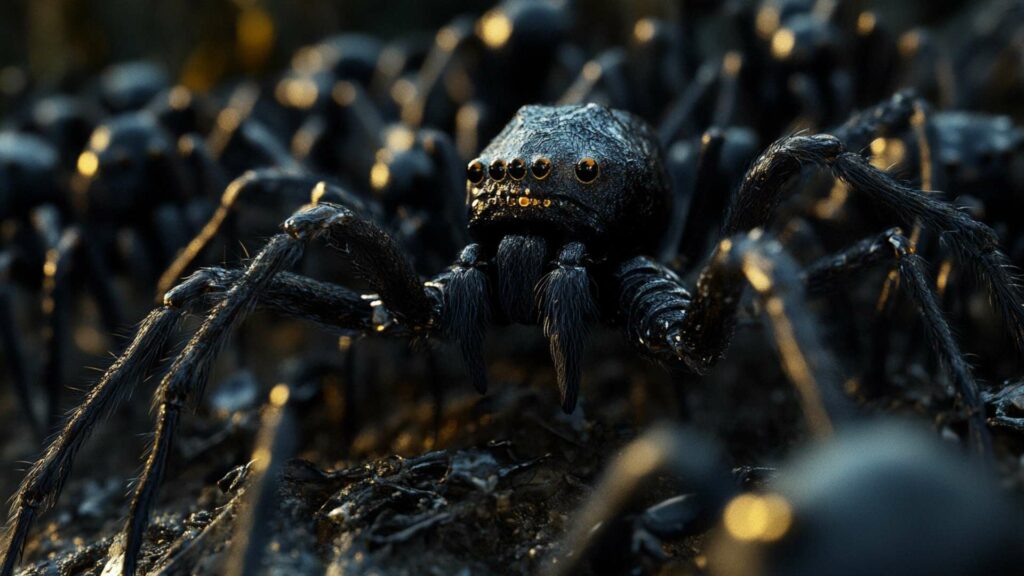
Role of prey moisture content in fulfilling spider’s water needs
Spiders, like all living creatures, need to drink water to survive. While they may not drink water directly like we do, they acquire it indirectly through eating their diet.
The moisture content of the prey plays a crucial role in fulfilling a spider’s water requirements. When a spider catches and devours its prey, it can extract moisture from their bodies.
The amount of available moisture varies depending on the type of prey and its size. Insects and other small creatures tend to have higher moisture content compared to larger animals.
So when a spider consumes smaller species like flies or mosquitoes, a dehydrated spider can obtain more moisture per unit of food consumed. On the other hand, larger prey such as grasshoppers or beetles have lower moisture content, so spiders might need to consume more individuals or seek additional sources of water to compensate for this reduced hydration.
Impact of prey size on the amount of available moisture
The size of the prey directly affects the amount of available moisture for spiders during feeding. Smaller insects tend to provide less overall nutrition but contain relatively higher amounts of liquid within their bodies.
This means that when a spider consumes multiple small insects compared to one large insect, it gains access to more water. For example, imagine a pet spider hunting down several small flies—a delightful feast!
Each tiny fly might not offer much sustenance individually but collectively provides enough liquid nourishment for the spider’s hydration needs as well. Conversely, if this same pet spider were to capture a single large grasshopper with low moisture content in its body, it would also need to have spiders drink water from supplementary sources of fresh water.
Different species of pet spiders employ various hunting techniques based on their adaptations and preferences. Some spiders actively stalk and pounce on unsuspecting insects using their speed and agility.
Others spin intricate webs that act as traps, capturing prey that inadvertently stumble into them. This diversity in hunting methods ensures spiders have different strategies to secure prey with higher moisture content, thus fulfilling their water needs indirectly.
Water Scarcity Challenges for Spiders
Impact of Droughts on Spider Populations
Droughts pose a significant challenge for spiders, as water becomes scarce and the survival of these fascinating creatures is put to the test. During periods of prolonged drought, the availability of natural water sources such as rivers, ponds, and even dew drops significantly decreases.
This scarcity can have a profound impact on spider populations, especially in areas where water is already limited. Spiders rely on water not only for drinking but also for maintaining their webs’ integrity and capturing prey effectively.
When droughts occur, spiders face difficulties in finding sufficient moisture to meet their daily needs. As a result, their populations may decline due to dehydration or an inability to build strong and functional webs that aid in hunting and survival.
Adaptations Developed by Certain Spider Species to Survive Without Regular Access to Water
Despite the challenges presented by water scarcity, certain spider species have developed remarkable adaptations that enable them to survive without regular access to water. One notable adaptation is their ability to minimize water loss through their exoskeletons. The tough outer layer of spiders helps retain moisture within their bodies by reducing evaporation.
Moreover, some spider species possess specific behavioral adaptations that allow them to conserve water effectively. For instance, during periods of limited water resources, certain spiders enter a state of dormancy known as aestivation or “summer hibernation.” During this period, they reduce their metabolic rate and become less active until more favorable conditions return.
Additionally, how much water is, some spiders have evolved physiological mechanisms enabling them to extract moisture from unconventional sources like prey insects. By consuming moist prey or feeding on creatures with higher hydration levels, these arachnids can supplement their water intake when natural sources drink water are scarce.
Behavioral Changes Exhibited During Periods of Limited Water Resources
When faced with limited water resources, spiders exhibit various behavioral changes to adapt and increase their chances of survival. For instance, some spider species actively seek out areas with higher humidity levels, such as deep crevices or shaded spots where moisture may be retained for longer periods. They instinctively navigate towards these microhabitats to combat dehydration.
Furthermore, spiders may modify their hunting strategies during dry spells. Instead of relying solely on building webs to catch prey, they may adopt more active hunting methods.
By using their adept front legs and keen sense of vibration detection, these resourceful creatures track down insects or other small organisms directly to suck water rather than waiting passively in a web. Water scarcity poses significant challenges for spiders in terms of population dynamics and individual survival.
However, through fascinating adaptations and behavioral modifications developed over time, certain spider species have successfully found ways to cope with limited access to water resources. These remarkable creatures have proven once again that nature’s resilience knows no bounds when it comes to ensuring the survival of its myriad inhabitants.
Human Interventions: Providing Water Sources for Spiders

Benefits and Considerations Regarding Creating Artificial Watering Spots
One might wonder why we should bother providing water sources for spiders when they seem to manage fine in nature. However, there are benefits to creating artificial watering spots for these eight-legged creatures. Firstly, it helps ensure their survival during dry spells or in urban areas where natural water sources may be scarce.
By offering a reliable water supply, we contribute to the overall health and well-being of spider populations. Creating artificial watering spots also allows us to observe these fascinating creatures up close.
It’s an opportunity to witness the drinking process firsthand, which is not something you get to see every day! Picture a small bottle cap and water bowl filled with water placed strategically in your garden.
Soon as enough water does, you’ll notice various spider species making their way towards it. From house spiders delicately sipping droplets from the surface to wolf spiders plunging their fangs into the water for a satisfying drink, it’s quite a spectacle.
However, there are certain considerations worth noting when establishing these artificial watering spots. Placement is crucial; ideally, they should be located in quiet and undisturbed areas of your garden or natural habitat nearby.
Safety precautions must also be taken so that other creatures do not fall into the water and drown inadvertently. By taking such measures and understanding the potential benefits of providing supplemental watering stations, we can contribute positively to spider populations while gaining insights into their behavior.
Effectiveness of Providing Supplemental Watering Stations
The effectiveness of providing supplemental watering stations for spiders largely depends on various factors such as location, accessibility, and climatic conditions. Generally speaking, if implemented correctly, these watering spots can prove highly effective in supporting spider hydration needs. Spider species that rely heavily on web-building can benefit greatly from supplementary water sources as it aids them in maintaining the delicate balance of moisture within their intricate webs.
Providing a consistent water supply can enhance web stability and yield better results in prey capture. Additionally, spiders that predominantly other spiders drink water from surfaces or water droplets can easily access these watering stations and stay hydrated.
It’s important to note that the effectiveness of supplemental watering stations might vary depending on the specific spider species present in the area. While some species readily adapt to alternative water sources, others may not show much interest or prefer obtaining their moisture solely through prey consumption.
Therefore, one should closely observe local spider behavior and adapt accordingly when establishing these watering spots. By considering factors such as location, accessibility, and adaptation to different spider species, we can increase the effectiveness of supplemental watering stations and help ensure our arachnid friends have access to water when needed.
Conclusion
Our exploration of the water needs of spiders has revealed fascinating adaptations and strategies employed by these eight-legged creatures. While it may seem surprising at first, spiders do require water to survive and thrive.
Their unique physiology, such as their exoskeleton and efficient water loss prevention mechanisms, allows them to retain as much water as possible within their bodies. In the wild, spiders acquire water from various sources.
They are adept at capturing raindrops and collecting dew on their intricate webs, utilizing these precious liquid resources both for their spider drinking water and maintaining the integrity of their webs. Additionally, spiders can obtain moisture indirectly by consuming prey with higher moisture content.
This ensures they meet their hydration needs even in arid environments. However, challenges arise when water becomes scarce in spider habitats due to factors like droughts or human-induced changes.
Some spider species have evolved adaptations to survive long periods without regular access to water. These fascinating creatures exhibit behavioral changes during such times or may rely on alternative methods for acquiring moisture.
As humans coexist with nature, we can also play a role in supporting spider populations by providing artificial watering spots when appropriate and feasible. Creating supplemental watering stations could help sustain spider communities during challenging times.
However, it is essential to consider potential ecological implications for long spiders while implementing such interventions. Understanding the importance of water for spiders allows us to appreciate the remarkable adaptability of these arachnids.
Despite misconceptions surrounding them, spiders have proven themselves resilient in diverse environments—showcasing that even an organism seemingly aloof from our daily concerns relies on this life-giving resource just like any other living being. So next time you spot a delicate orb-weaver weaving its intricate web or catch sight of those elusive brown recluse spiders lurking in corners—remember that beyond spinning silk threads and capturing prey lies an incredible world where drinking water is just as crucial as it is for any other creature on this planet.
Master the challenge of spiders with D-Termination: Las Vegas’ leading Pest Control service!

Troubled by spider presence within your Las Vegas property? D-Termination offers the remedy. Our proficient team excels in eradicating spider infestations, reinstating a sense of peace and calm to your environment. Bid farewell to spiders—opt for D-Termination’s potent pest control today!
Reach out to us at 702-919-6310 or explore dtermination.com to schedule your spider control service and regain your space from these unwelcome intruders.
Frequently Asked Questions:
Yes, you can offer water to a spider, but they usually get moisture from their surroundings.
House spiders usually get water from their food or absorb it from the air.
Spiders don’t typically enjoy being in water; they’re better suited to their dry habitats.
House spiders don’t have a preference for water; they generally avoid it.








